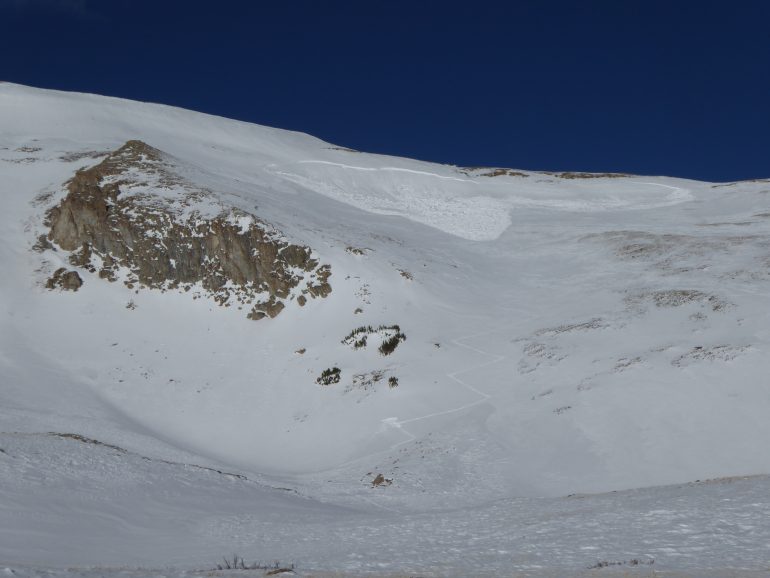As of January 31, we have documented 57 people caught in 42 separate avalanche events. Seven of the people have been critically (head under the snow) or fully buried, and two have died. 60% of the involvements this season occurred in January alone, including both fatalities.
Those are impressive and scary numbers.

Backcountry tourers triggered and were caught in this avalanche while ascending, Sawatch Range December 14.
How does this season compare to previous years? Before answering that question, there are several things to consider when we talk about avalanche accidents. We do know how many people avalanches kill. Fatal accidents are investigated and documented, which gives us confidence in the data. We do not know how many people are caught, injured, or buried in avalanches. We only know what people tell us. Many involvements go unreported, for reasons varying from embarrassment to people not knowing that we are collecting information or even that the CAIC exists. When there are well-publicized incidents, we tend to learn about other events. Thus, the number of people caught is an approximation, but we think it is indicative of patterns in avalanche involvements. The number of fatalities and incidents is relatively small, too. That means a single large event, like the 2013 accident in Sheep Creek, has a large impact on annual and multi-year trends.
So, caveats in mind, how does it look like 2018-19 will compare to previous years?
Comparing fatalities, 2018-19 looks similar to recent years. In four of the previous six winters, there were two or three fatalities by the end of January. The differences in total seasonal fatalities over recent winters tend to appear in February or April. Over the last few decades, most fatal avalanches occur in January, February, or March. Accidents in the spring separate typically tragic from exceptionally tragic seasons.
Comparing involvements paints a different picture. There were 32 people caught in avalanches in January 2019. That is nearly three times more people than in previous Januaries. Of the past 40 months with avalanche incidents, we only recorded more involvements in February 2013. The 56 cumulative involvements this year are far more than we recorded for all of 2017-18, 2015-16, and 2014-15. If we project similar rates to the end of the season, 2018-19 will be by far the most people involved in avalanche that we have recorded.
Only 6% of the people caught in avalanches in January died. That is slightly better than the long-term annual fatality rate of 8%. Several months, like February 2016 or April 2013, we documented relatively few involvements compared to fatalities and the fatality rate was over 20%. Those months highlight the potential uncertainty within monthly comparisons and the sensitivity of the small numbers in the dataset.
While these comparisons are interesting, there is not a single, easy explanation. There were 1113 avalanches record in January 2019, making it among the highest monthly totals. More avalanches were recorded in January 2017, though, with no fatalities that month. It is not simply a function of more avalanches. The type of avalanche may contribute. This winter, many of the avalanches ran on persistent weak layers while many in January 2017 ran on storm instabilities. More people are recreating in the backcountry, which could increase the number of interactions with avalanches. Those people may be reporting their involvements more often than in the past. We are learning about more close calls and successful companion rescues, possibly improved avalanche safety equipment. The line between avalanche tragedies and close calls may only be a matter of luck. A few events go slightly different–someone misses a tree, someone is caught further out on the slab–and our season could look very different.
